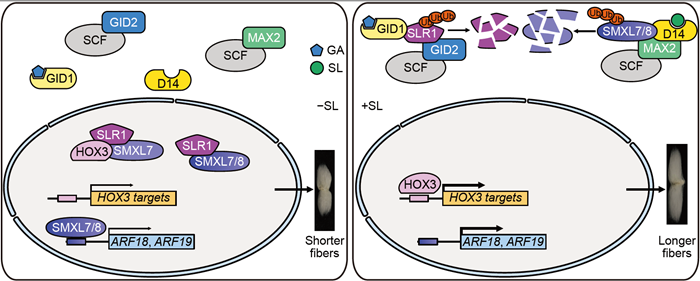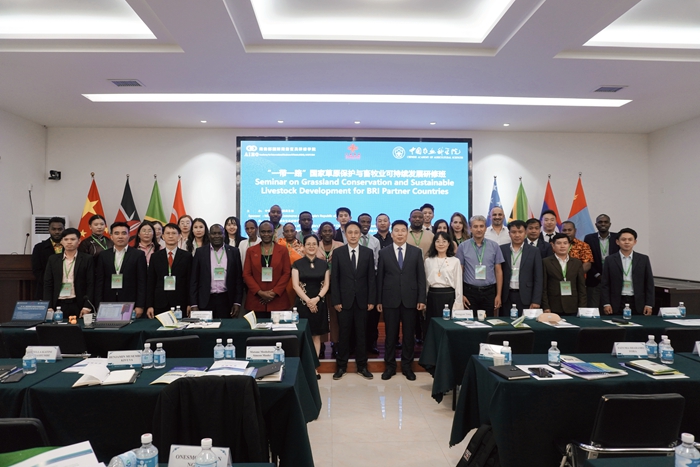Strigolactone-induced degradation of SUPPRESSOR OF MORE AXILLARY GROWTH2-LIKE7 (SMXL7) and SMXL8 contributes to gibberellin- and auxin-mediated fiber cell elongation in cotton
Recently, a research team led by Professor Guoli Song of Chinese Academy of Agricultural Science, Institute of Cotton Research (CAAS, ICR) revealed a novel mechanism by which strigolactones (SLs) regulate cotton fiber development. The findings were published in the prestigious international journal "The Plant Cell" under the title "Strigolactone-induced degradation of SUPPRESSOR OF MORE AXILLARY GROWTH2-LIKE7 (SMXL7) and SMXL8 contributes to gibberellin- and auxin-mediated fiber cell elongation in cotton".
Strigolactones (SLs) are a new class of plant hormones that play important roles in regulating plant architecture, responses to abiotic stress, and nitrogen utilization. Recent studies have showed that SL is also involved in regulating cotton's resistance to verticillium wilt and fiber development. Reports suggest that SL acts downstream of gibberellins (GA), collaboratively promoting fiber cell elongation and secondary wall thickening. However, the mechanisms by which SL regulates the development of single-celled fibers remain poorly understood.
Through IP-MS assay, the authors identified that the repressors of the SL pathway, GhSMXL7/8, interact with the DELLA protein GhSLR1. Further experiments demonstrated that GhSMXL7/8 can competitively bind to GhSLR1 with the F-box ubiquitin ligase GhGID2, thereby obstructing the GA-mediated ubiquitination and degradation of GhSLR1. Additionally, GhSMXL7 was found to interact with the transcription factor GhHOX3, inhibiting its transcriptional activation of downstream genes. The authors also found that the SL synthesis inhibitor Tis108 significantly suppressed the promoting effect of IAA on fiber elongation, suggesting that SL may also be involved in regulating the synthesis or signal transduction of auxin within fibers. Finally, the authors revealed that GhSMXL7/8, acting as transcriptional repressors, can directly bind to the promoters of GhARF18/19 and inhibit their transcription, resulting in shorter fibers. This research unveils a new mechanism by which strigolactone, gibberellin, and auxin interact in a signaling crosstalk to synergistically regulate cotton fiber development.
This research was supported by the National Natural Science Foundation of China (CAAS). Professor Guoli Song is the corresponding author, while doctoral student Yaru Sun from is the first author.
Article is available on:https://doi.org/10.1093/plcell/koae212

Schematic model depicting the function of GhSMXL7 and GhSMXL8 in regulating fiber cell elongation
By Sun Yaru (syrfighting123@163.com)
-
 Aug 22, 2024Seminar on Grassland Protection and Sustainable Livestock Development for BRI Partner Countries has kicked off in Hohhot
Aug 22, 2024Seminar on Grassland Protection and Sustainable Livestock Development for BRI Partner Countries has kicked off in Hohhot -
 Aug 01, 2024Deputy Prime Minister of Cuba Visited IVF-CAAS
Aug 01, 2024Deputy Prime Minister of Cuba Visited IVF-CAAS -
 Aug 01, 2024CAAS Vice President Visits Africa
Aug 01, 2024CAAS Vice President Visits Africa -
 Jul 16, 2024FAO Director-General Visits CAAS
Jul 16, 2024FAO Director-General Visits CAAS -
 Jul 16, 2024CAAS President Meets Vice Chancellor of University of Sargodha
Jul 16, 2024CAAS President Meets Vice Chancellor of University of Sargodha
